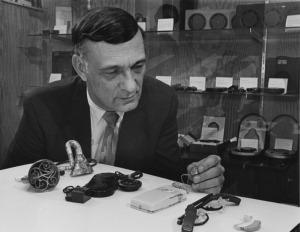This week, I’ve been preparing to exhibit a few items from our hearing aid collection. In my research, I found it very interesting (yet logical) that technological developments in this field were closely related to the telephone, microphone, and radio. I visited the Kenneth W. Berger Hearing Aid Museum at Kent State University to learn more about the evolution of hearing aids.

The New York Eye and Ear Infirmary opened in 1820 and the first textbook on the ear and its diseases was published in 1821. Otology became a medical specialty in the United States around 1860, but it was several decades to develop hearing aids that could assist people with more than a mild hearing loss.
The first devices used to help people with mild to moderate hearing loss were generally called “ear trumpets.” Their use dates back to the 1600s, but they didn’t become popular until the late 1700s. The development of these instruments relied heavily on the study of acoustics. They simply amplified sounds through their shape. Typically, they were used in only one ear. They were relatively inexpensive and, because they were so simple, could be purchased without the help of a doctor.

The next big development in hearing aids came in the late 1800s with the development of the telephone. This technology was adapted to create simple “electric” hearing aids that contained carbon. The vibrations of speech would create friction in the carbon that was enough to produce an electrical charge that amplified the sound. At first, these devices were large, tabletop models. Around 1902, devices that were smaller and could be worn on one’s clothing were developed. These hearing aids used a 3- or 6-volt battery but were still only suited to assist those with mild to moderate hearing loss.

and its effectiveness was sensitive to changes in temperature.
In the 1930s, powerful hearing aids using vacuum tubes were developed that could help people with severe hearing loss. By the early 1950s these were replaced with transistors since they only needed one battery instead of two. These transistor hearing aids became much smaller in 1964 when the integrated circuit was added. This smaller size lead to the development of many interesting styles of hearing aids including eyeglasses, broaches, and pens. Behind-the-ear and over-the-ear models were very popular for people with severe hearing loss.
Check out the exhibit in Cushwa Hall to see some early hearing aids like a conversation tube, hearing dome, ear trumpet, and Acousticon!
